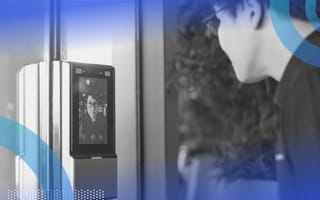The growth of artificial intelligence innovations this year is a clear indicator of the power of well-developed AI and its ability to reinvent how work is carried out across sectors.
What Is Facial Recognition?
Facial recognition is a form of biometric technology. Leveraging artificial intelligence and a video input, a facial recognition algorithm takes highly detailed measurement data on an individual’s facial proportions to verify identity or gather other insights such as their approximate age.
However, while generative AI might be holding court today, there are a vast array of advanced artificial intelligence applications that have been making huge strides, especially in the biometrics field.
Market analyses now predict the facial recognition space in particular, to experience a compound annual growth rate (CAGR) of 16.13 percent from 2023 to 2030. That’s almost three times the growth expected of the fingerprint market over the same period.
Necessary debate continues over the ethical use of this powerful technology for “in the wild” use cases, as well as use of the technology without the consent of individuals. However, many industries are pushing forward in the use of facial recognition for user-first cases that prioritize safety and convenience. Here are five facial recognition applications making waves across retail, manufacturing, hospitality, automotive and healthcare.
Facial Recognition in Retail
As brick and mortar retailers have grappled with booming e-commerce competition, many are turning to Vision AI to create more personalized in-store experiences that mimic the conveniences we enjoy with online shopping.
Vision AI is a type of computer vision that stops short of recognition. Instead of matching faces to a database, it gathers demographic data on who is entering a store at what times. With this information in hand, store managers are fine-tuning shopping experiences, from adjusting advertised discounts to the time of day to the music playing in the background as customers shop.
Banking leaders like JPMorgan are also pioneering a facial recognition-based future of payments, which makes store checkout a possibility without your wallet or even your phone. In a pilot program beginning in May, the bank will test face and palm biometrics payments across selected retail stores, and at the Formula 1 Grand Prix in Miami.
Facial Recognition in Manufacturing
Manufacturing has been one of the earliest adopters of facial recognition technology because manufacturing facilities see such a high quantity of employees each day. Additionally, ensuring the right, trained individuals are on the correct line could mean the difference between a working product and a faulty one.
Toyota has been a pioneer of AI in manufacturing, using both facial recognition and computer vision for several functions within their plants. Facial recognition is integrated as part of quality control processes, leveraging an instant verification of each individual who performs a quality check on the section of the car that falls under their expertise. Computer vision is also being used to analyze the safety and productivity of worker activities. The computer watches the work being carried out and can make recommendations for individuals to conduct a certain movement or process more safely or efficiently.
Many other plants and manufacturing facilities are also upgrading secure entry points and clock-in clock-out systems with face-based verification.
Facial Recognition in Hospitality
According to a recent report from Hospitality Technology, 73 percent of guests say they are likely to return to a hotel that meets their technology needs, and properties are looking to AI to enhance guest convenience.
The FlyZoo Hotel was one of the first to integrate facial recognition for keyless guest room entry, but the trend has continued since with touchless technologies being prioritized for guest health and safety.
Keyless room entry powered by AI enhances convenience, allowing guests to skip check-in desk lines and avoid getting locked out of their room if they lose a keycard. For high-end properties, facial recognition is even being explored to recognize VIPs and pull up their preferences when they arrive at the on-site restaurant, spa or other amenity.
Facial Recognition in Vehicles
Facial recognition found its way into cars several years ago but the use cases are continuing to expand with each year’s new models.
Just this year, Genesis announced the first-ever car entry by face capability, allowing owners to access their vehicles without keys anywhere on their person.
Meanwhile, Hyundai is using facial biometrics to automatically adjust seating, displays, mirrors and entertainment systems to the driver’s preferences. Subaru uses its DriverFocus system to monitor for potential fatigue or lack of attention at the wheel.
Healthcare Upgrades for Patients and Providers
Like manufacturing, the healthcare sector was among the earliest adopters of facial recognition, beginning with smart medicine cabinets which only grant access to narcotics and other restricted drugs to verified doctors and nurses.
Now, hospitals like Martin Luther King, Jr. Community Hospital in Los Angeles are using facial recognition to secure entry to entire wings. On the diagnostics side, doctors are also exploring the use of facial recognition for early stroke detection.
As illustrated across these examples, the use cases of facial recognition are incredibly wide ranging across industries, but all hold convenience and safety at their core. What new applications can we expect to see over facial recognition’s period of turbulent growth ahead? Only time can tell.





